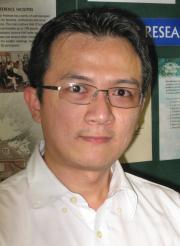
A talk was given by Dr Ean-Hin Ooi from Nanyang Technical University in Malaysia on Ocular Heat Transfer in the Human Eye using the Boundary Element Method.
The lecture began by describing the anatomy and physiology of the eye and the importance of temperature modelling for a range of problems. Ean-Hin developed an axisymmetric model taking into consideration the shapes and properties of the different components and tissues. He also discussed the way in which convection and radiation boundary conditions are prescribed, including the case of tear evaporation.
A linear BEM model was used to solve the problem. Computer results were compared with temperature measurements published by other authors.
The model was then used to study thermokeratiplaty (TKP) treatment. TKP is used to improve corneal refractive power by applying laser surgery. The resulting rise in temperature changes the curvature of the cornea. This entails extending the governing equations to model laser inputs of two types, continuous beam and pulse laser.
In order to represent the resulting volume integrals, Ean-Hin has applied the Dual Reciprocity Method (DRM) by Brebbia and Nardini. In addition, the time derivatives were discretised using a time stepping technique.
Comparison of pulse and continuous laser treatment were also presented and the effect of thermal damage estimated. This damage was proved to be smaller in the case of the pulse laser. This is an important result as continuous wave laser beam surgery is currently the preferred choice for this treatment. Surgeons ought to start considering using pulse laser instead.
Ean-Hin then described some of the most recent bio-engineering work he has been involved with in the field of human fertility studies. This includes the computer simulation of spermatozoid movements.

 Wessex Institute
Wessex Institute